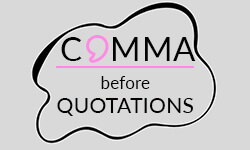
For clarity and structure in academic writing, commas play an essential role, especially, when using quotations in discourse. When incorporating quotations into text, it is integral to separate the quoted words from the written text. Correct comma placement preserves the flow and correct meaning in a written work, as well as, ensures accurate grammar. This article delves into the scenarios of when to use a comma before quotations and when to leave it out.
When to place a comma before quotations
In grammatical terms, quotations are prominently syntactically independent, which means they typically stand apart from the rest of the text. Generally, when a quotation is syntactically independent, a comma is placed before quotations to indicate a clear separation between the text and the quoted material. Quotations can be introduced by dialogue tags, introductory phrases, and statements, and can be embedded in a sentence in various ways.
Comma
Syntactically independent
After introductory phrases
After dialogue tags
After statements
No comma
Syntactically integrated
Introduced by conjunction
Comma rules before quotations depend on the chosen Style Guide for an academic paper. Although the overall rule is that a comma should be placed before a quotation to indicate separation and highlight the quotation, there are specific rules for each Style Guide and also for the type of quotation that is incorporated in the text. In numerous instances, commas or even quotation marks are omitted for block quotes (longer quotes).
Comma before quotations
In essence, when a quotation is embedded within a sentence and doesn’t contribute to the syntax, a comma must always be placed before the quotation. Usually, these types of quotations are introduced by introductory phrases, dialogue tags, or statements.
Note: Quotations that are fragments or phrases should not be capitalized!
Syntactically independent
When a quotation can stand on its own, meaning it is independent from the surrounding text, it is referred to as syntactically independent. In these scenarios, a comma must always be placed.
After introductory phrases
When a quotation follows an introductory phrase, a comma is necessary before the quotation. An introductory phrase is the context that leads into a quotation.
After dialogue tags
Dialogue tags typically include verbs such as “to note,” “to state,” or “to mention.” When they precede a quotation, you should place a comma. This also applies when the dialogue tag and following quotation are placed in the middle of a sentence.
After statements
When a statement represents the opening in a sentence and introduces a quotation, you must place a comma before the quotation.
No comma before quotations
Syntactical integrated quotations go with the flow of a sentence, meaning they blend into the rest of a sentence. Additionally, when a quotation is introduced by a conjunction like “if,” “that,” or “whether,” a comma before the quotation is left out.
Syntactically integrated
Syntactical quotations are directly integrated components of a sentence. As they are not introduced by introductory phrases, dialogue tags, or statements, there is no need for a comma before the quotation to indicate a clear separation from the rest of the sentence.
Introduced by conjunctions
When a quotation follows a conjunction such as “if,” “that,” or “whether,” you must omit the pre-comma. The conjunctions incorporate the quotation into the sentence’s syntax, making it an integral part of the clause, which is why there is no need to separate the sentence.
Test yourself!
Practice sheet
Test if you grasped the correct understanding of placing a comma before quotations with the 10 sentences below. Check your answers in the second tab.
- She whispered “Be quiet,” as we entered the room.
- “Can you believe it,” he exclaimed “they won the game!”
- I couldn’t understand why she said “I am leaving” so abruptly.
- She said, waving goodbye “I’ll see you tomorrow.”
- He asked if “the meeting is still on for Friday.”
- The note read “Meet me at noon.”
- She wondered whether “it would rain later in the day.”
- He thought, looking at the view “This is wonderful.”
- The teacher announced “Class is cancelled tomorrow.”
- He couldn’t decide if “this was a good idea or not.”
- She whispered, “Be quiet,” as we entered the room. (Comma)
- “Can you believe it,” he exclaimed, “they won the game!” (Comma)
- I couldn’t understand why she said “I am leaving” so abruptly. (No comma)
- She said, waving goodbye, “I’ll see you tomorrow.” (Comma)
- He asked if “the meeting is still on for Friday.” (No comma)
- The note read, “Meet me at noon.” (Comma)
- She wondered whether “it would rain later in the day.” (No comma)
- He thought, looking at the view, “This is wonderful.” (Comma)
- The teacher announced, “Class is cancelled tomorrow.” (Comma)
- He couldn’t decide if “this was a good idea or not.” (No Comma)
numerous advantages for Canadian students:
- ✓ 3D live preview of your configuration
- ✓ Free express delivery for every order
- ✓ High-quality bindings with individual embossing

FAQs
Unless the quotation follows the flow of a sentence or is introduced by a conjunction, you primarily place a comma before quotations. Essentially, you must differentiate if the quotation is syntactically independent or integrated to determine whether to place a comma before it or not.
Quotation marks are commonly used for direct quotes, titles, or phrases. They are always used in pairs, enclosing the quoted material. Generally, most punctuations are placed within the quotation marks.
Quotations positioned in the middle of a sentence are typically separated by commas. Commas, periods, exclamation points, or question marks that follow a quotation must be placed within the quotation marks.
Examples
- He shouted, “I am excited about the trip!”
- The book read, “Start at the back of the book.”
- According to the reporter, “This war will never end.”
Yes. All punctuations ending a quotation are placed inside the quotes.
